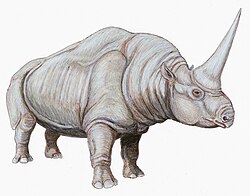| Brachydiastematherium Temporal range: | |
|---|---|
 | |
| Holotype of B. transylvanicum. | |
| Scientific classification | |
| Kingdom: | Animalia |
| Phylum: | Chordata |
| Class: | Mammalia |
| Order: | Perissodactyla |
| Family: | † Brontotheriidae |
| Genus: | † Brachydiastematherium Böckh & Matyasovski, 1876 |
| Species: | †B. transylvanicum |
| Binomial name | |
| †Brachydiastematherium transylvanicum Böckh & Matyasovski, 1876 | |
Brachydiastematherium (literally "short diastema beast") is a genus of Eocene brontotheriid. It is the westernmost species of brontothere, with the first fossils of it being found in Transylvania, Romania. Only the type species, B. transylvanicum, is known. [1]









